When we study a new song for the first time, it is useful to know its anatomy. How is it built up? What are the tonalities that are used? How does it transition from one tonality into the next? What are the scales I can use in a solo? To answer those questions we need to do a Harmonic Analysis of the song.
In this article, I will try to explain some of the facets involved in harmonic analysis in the way that I use them and that I find easy to understand.
I would like to point out that my methods are not the only way to analyze a song. There are other ways that will lead to different outcomes… Not everyone uses the same scales over chords in any specific function and there are lots of ways to interpret what is written down. I would say that this is one of the nice things about music; there is plenty of diversity.
That being said, I would like to encourage people with different methods and tricks to join in on the discussion by commenting at the bottom of this post! I would love to learn from them!
Using All Of Me
As a practical example of harmonic analysis, we will look at the very famous jazz standard written by Gerald Marks and Seymour Simon back in 1931: All Of Me.
All Of Me really is an iconic song in the world of Jazz Standards performed by artists like Frank Sinatra, Louis Armstrong, Ella Fitzgerald, … The list goes on and on.
It is one of those songs that isn’t overly complex because it is a ballad, yet it shows a lot of the typical chord patterns and progressions that are most common in today’s Jazz music.
In order for you to follow along, I have prepared a score for you to download. It is a very basic version of the song that shows the melody, very basic clustered root chords and a simple walking bass line. It is more than we need to do our analysis.
All Of Me – Basic Version
Download the Score
Listen to the Score
Analyzing the Chords and Scales


The Jazz Theory Book explains all information any Jazz student needs in an easy-to-understand, yet thorough, manner.
The Jazz Piano Book on the other hand is more like a compendium of Jazz Piano. It has all information but it does not teach, rather it is great for refreshing your memory in a super concise way.
Both are must have books for any Jazz Pianist!
Click on the images to be taken to Amazon.com
The Main Key
There are a few hints towards what is the main key of this song.
- The key signature has no sharps or flats
- The song starts on a Cmaj7 chord
- The song ends on a C6 chord
From that, we can deduce that the main key in which this song is written is most likely the key of C major.
The Diatonic Sequence of C Major
| I maj 7 | II min 7 | III min 7 | IV maj 7 | V 7 | VI min 7 | VII min 7 b5 |
|---|---|---|---|---|---|---|
| C maj 7 | D min 7 | E min 7 | F maj 7 | G 7 | A min 7 | B min 7 b5 |
So with this basic information, we can start the basic analysis using roman numerals.
Measures 1 through 8
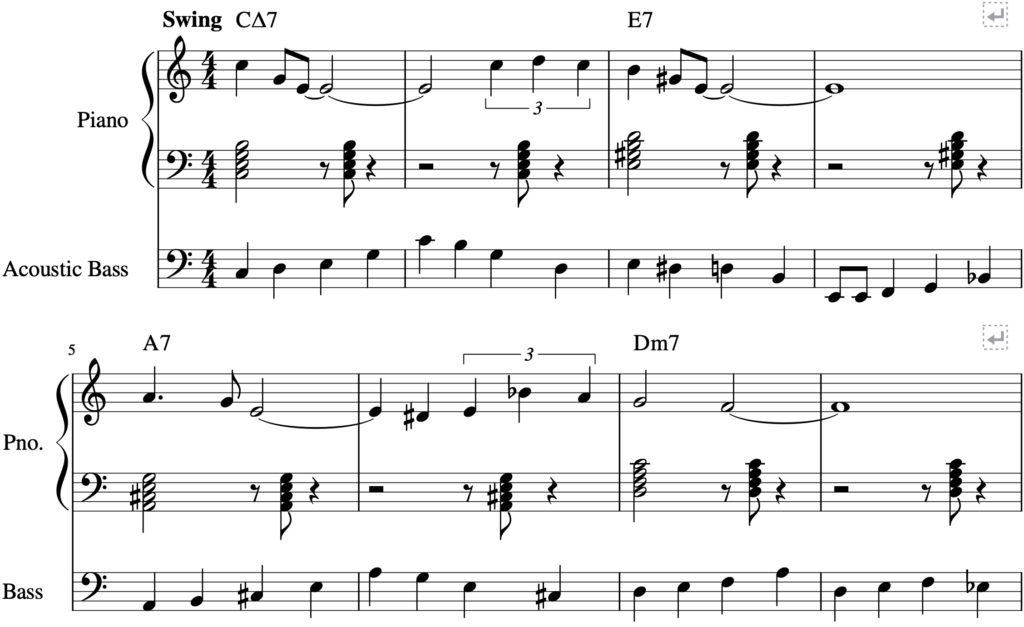
Chord Analysis
Of the first four chords that we see: Cmaj7, E7, A7 and Dm7 only the first and the last really belong to the diatonic sequence of C major: Cmaj7 and Dm7
When we look at the other two chords, it is quite obvious that those are dominant chords. There is one thing we know about dominant chords; they usually want to resolve to their tonic, which is an ascending perfect fourth from the route.
So we know now that E7 would want to resolve to A, and A7 would want to resolve to D… Well, guess what! It is no coincidence here!
These types of dominant chords are called secondary dominants, and we use roman numerals to relate them to the main key:
E7 would be the V degree of A major BUT the A in the diatonic sequence of C major is the VI degree.
A7 would be the V degree of D major BUT the D in the diatonic sequence of C major is the II degree.
The first 4 chords are therefore defined:
Cmaj7: I
E7: V of VI or V/vi –> vi in lowercase to show that this is a minor degree
A7: V of II or V/ii –> vi in lowercase to show that this is a minor degree
Dm7: II
Scale Analysis
Again, for Cmaj7 and Dm7 it is easy, those are diatonic chords and we will, therefore, use their degree modes which are respectively C Ionian and D Dorian.
If you have no clue what modes are… And Ionian and Dorian are Greek to you (pun intended) keep your eyes on this website, a dedicated article will come in the near future!
As far as our secondary dominants are concerned, as a rule of thumb, if they resolve to a minor degree of the main key, you can use the Mixolydian scale from the root of the secondary dominant but with a b9 and a b13.
That scale is also known under a different name: the Phrygian Dominant scale. I know, it almost sounds like a type of dinosaur…
Incidentally, the Phrygian Dominant scale is the fifth mode of the harmonic minor scale. So over E7, you can play the A harmonic minor scale and over A7 you can play the D harmonic minor scale.
Personally, though, I find the following way easier to remember when I think of secondary dominant chords like this:
The fifth degree of a major scale would normally be Mixolydian, but because it is resolving to a minor degree we need to adjust that Mixolydian scale with a b9 and a b13.
That is not a scientific explanation, it is a mnemonic that skips a few steps… Aha, a secondary dominant to a minor degree so I have the minor degree’s harmonic minor scale and the fifth mode of that is Phrygian Dominant scale, goodness me… I can’t wrap my head around that while I am playing!
Here are the scales for the first 8 measures of the song:
Cmaj7 –> C Ionian – First mode of C major
E7 –> E Mixolydian b9 b13 (also called: E Phrygian Dominant ~ A harmonic minor)
A7 –> A Mixolydian b9 b13 (also called: A Phrygian Dominant ~ D harmonic minor)
Dm7 –> D Dorian – Second mode of C major
Measures 9 through 16
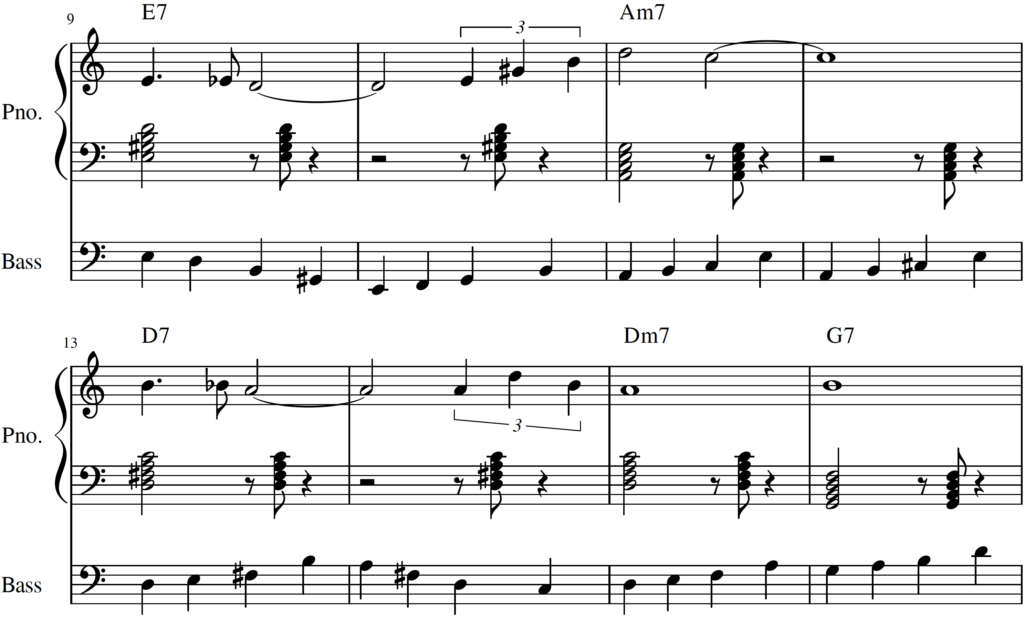
Chord Analysis
Of the five chords, three belong to the diatonic sequence of C major: Am7, Dm7 and G7
They represent respectively the VI, II and V degree.
Again we have two secondary dominant chords, the first of which we already know: E7 resolves to A and will, therefore, use the Mixolydian b9 b13 scale again.
The D7, at first sight, is not resolving into G. However, as you may know, any dominant V chord may be replaced by a quick II – V progression. And so Dm7 – G7 can be seen as a substitution of just G7.
Thus D7 is indeed resolving to G and is therefore identified as a V of V or V/V.
And there we have the definition for the next five chords:
E7: V of VI or V/vi –> vi in lowercase to show that this is a minor degree
Am7: VI
D7: V of V or V/V –> V in uppercase to show that this is a major degree
Dm7: II
G7: V
Scale Analysis
As previously, the diatonic chords will use the mode that belongs to their degree so for Am7, Dm7 and G7 respectively will be A Aeolian, D Dorian and G Mixolydian.
The E7 will be handled the same as previously as it still resolves to A. So we will stick with E Mixolydian b9 b13.
The D7 is slightly different because it resolves into a major degree of C major: the fifth (V) degree. The only difference between the diatonic chord Dmin7 and D7 is the modulation from F to F#. If we were to adjust the F in the C Ionian mode to an F#, this would result in the C Lydian scale which is the fourth degree of G major.
The fifth degree of G major is D Mixolydian…
Ok to cut a long story short:
With V/V chords you can use the Mixolydian scale on the root of the secondary dominant. (I hope that makes sense?)
That results in the following scales for measures 9 through 16 of All Of Me:
E7 –> E Mixolydian b9 b13 (also called: E Phrygian Dominant ~ A harmonic minor)
Am7 –> A Aeolian – Sixth mode of C major
D7 –> D Mixolydian – Fifth mode of G major (relates as C Lydian mode)
Dm7 –> D Dorian – Second mode of C major
G7 –> G Mixolydian – Fifth mode of C major
Measures 17 through 24
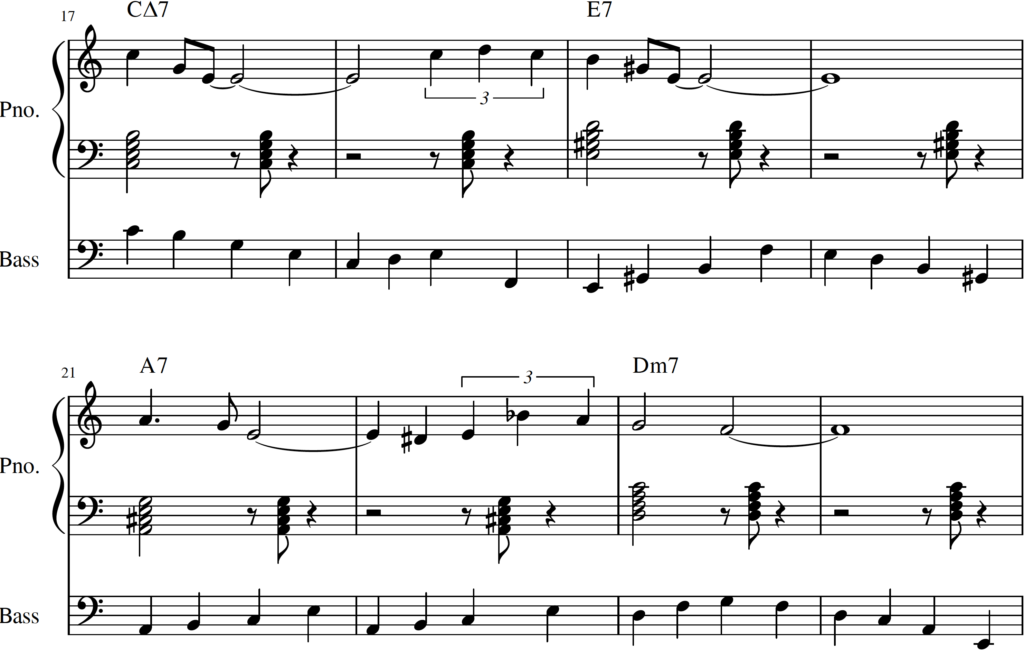
Chord Analysis
This is an exact repeat of measures 1 through 8 so please refer back to that section.
Scale Analysis
This is an exact repeat of measures 1 through 8 so please refer back to that section.
Measures 25 through 32
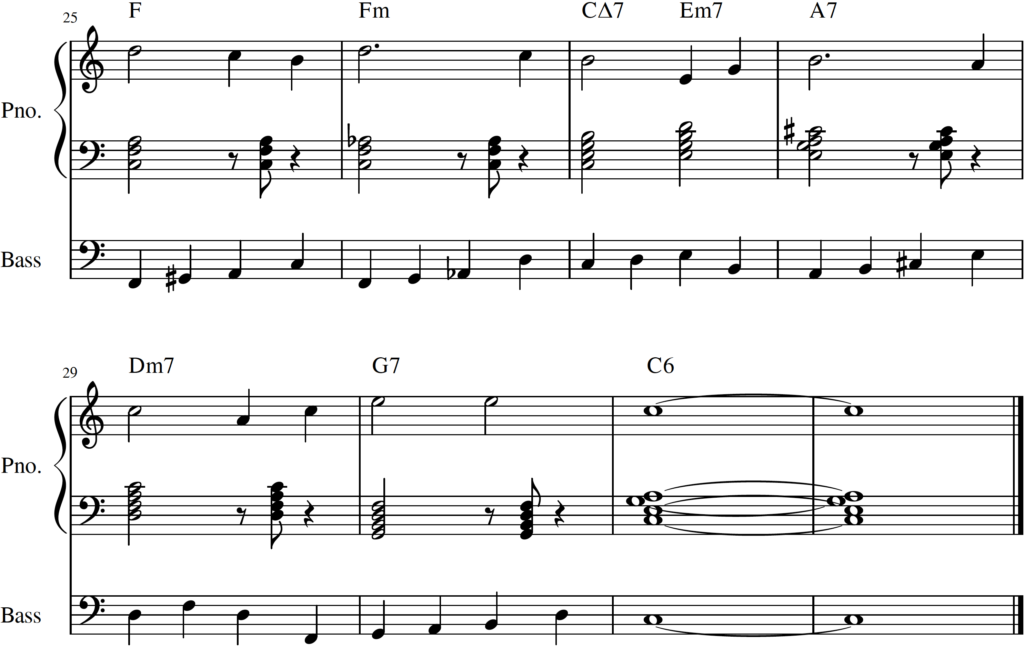
The final stretch…
Chord Analysis
In these last eight chords, there are only two chords that don’t belong to the diatonic scale of C major: Fm and A7
Of those two chords, we already know how to handle A7. It is handled as the V/ii secondary dominant.
The one chord that is puzzling in this progression is the Fm chord. So where does this chord come from and how do we find out how it functions here. We will elaborate on this during the scale analysis, for now, we will identify the chord as a minor fourth degree of C major (IVmin or iv).
F: IV
Fm: IVmin or iv –> in lowercase to show that this is now a minor degree
Cmaj7: I
Em7: III
A7: V of II or V/ii –> vi in lowercase to show that this is a minor degree
Dm7: II
G7: V
C6: I
Scale Analysis
We can focus here on the one chord that is different from all other chords. What is this Fm and what scale can we use?
If we look at it from the perspective of its notes; to get from F to Fm we need an Ab. So let’s think about that for a moment.
The key signature that is closest to C major that has an Ab?
–> The key signature of Eb major which has Bb, Eb and Ab.
How does C relate to the Eb major scale?
–> C is the sixth degree of Eb major.
Ok, that means C is the relative minor of Eb!
In other words, the song is making a quick jump to C minor. A jump from a major key to a minor key with the same root note is something that happens relatively regular in songs, so it is something to remember as a possibility.
F: F Lydian – Fourth mode of C major
Fm: F Dorian – Second mode of Eb major ~ Fourth mode of C minor
Cmaj7: C Ionian – First mode of C major
Em7: E Phrygian – Third mode of C major
A7 –> A Mixolydian b9 b13 (also called: A Phrygian Dominant ~ D harmonic minor)
Dm7: D Dorian – Second mode of C major
G7: G Mixolydian – Fifth mode of C major
C6: C Ionian – First mode of C major
All Of Me – Analyzed Version
Download the Analyzed Score

When you read this book, you will completely understand how to implement harmony in your own music for composing, and in your improvisations when playing Jazz Standards.
It is very much focussed on piano, so that is a great benefit for us lowly piano-men :).
Click on the image to be taken to Amazon.com!
Listen to the Analyzed Score
And you can listen to how the scales sound over the chords.
Warning, this will sound very bland, but it should give you a good idea on what the scales sound like.
What Comes After Harmonic Analysis?
Now that we have analysed the song, we have a fair idea of what scales we can use to improvise over the song. Also now that we are armed with the scales we can work on our voicings when comping on the piano. We can use the scales to build out upper structure triads that we can use to really flesh out the feel of our chords.
In a future post, this is exactly what we will be doing. I will be showing a very hands-on method for building upper structure triads on a chord progression.
Keep walking the piano walk!
My number one recommendation to learn the piano in a fun and hassle-free manner is a program called Flowkey. Go try it out for free ► https://go.flowkey.com/pianowalk

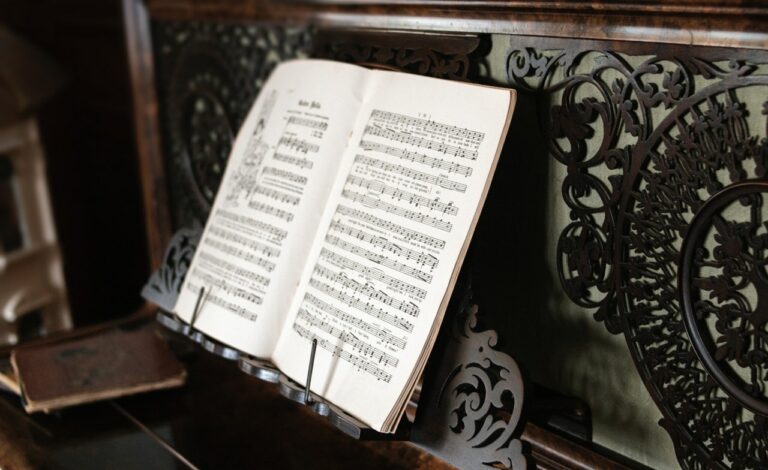
13 Comments
I’m pretty shocked that you provide so much value in a single post! I know a bit about piano from playing for years, but I don’t know theory outside of scales and I can only read music slowly.
Even with those limitations, I learned a ton! I didn’t know how jazzy I could make chords sound by adding the 7th note in the scale.
I learned a lot of vocabulary too. I’m happy to be a subscriber!
Hi Lyle!
Glad you got a lot of value out of this post. Yes, I do put in a lot of information.
What is funny is that this was a sidetrack I was taking in another post, but I decided to make it a post on its own.
It is rather easy to overwhelm people when the post gets too long 😀
I suppose it is a bit of a balancing act.
Welcome to the family!
And if there are ever any questions or you need info on a subject, I will be happy to help!
Cheers,
Tom
Hi Tom!
I’m playng vibraphone and because of this short explanation, I now have an idea how to do comping a little better. Because I struggle when playing the chords more gentle to or around the melody.
Thank you!
Hi Sebastian,
Glad I could help 🙂
Hi
More like this, please.
In the 5th ed. (I think) of the real book, the lead sheet for All of Me has at the end following the C6 chord the following bracketed (E♭° – Dm7 – G7) chords. What do the brackets signify, and where does E♭° come from?
Very nice post, thanks!
Anthony
Hi Anthony,
Thank you for your feedback.
The bracketed chords at the end of a section in a jazz song are what they call a turnaround. Those chords guide you into the next section of the song, or back to the start of the song as is the case with this particular turnaround.
If you stop at the C6, you have arrived at a stable chord and that gives a sense of finality or the end of the song in other words.
Because, as you know, it is custom in jazz that the song will be repeated multiple times over to give other instruments a chance to improvise, the turnaround is used to lead us back to the start of the song and to avoid the feeling that the song was over.
There are a few very often used formulas to form these turnarounds and one of those formulas is the 1 – b3dim7 – 2 – 5 – 1
(Cmaj7 – E♭° – Dm7 – G7 – Cmaj7)
The E♭° is a transition chord that resolves to the diatonic chord a semitone lower => Dm7
After that, it is just a 2 – 5 (Dm7 – G7) that leads back to the start of the song with Cmaj7.
I hope that helps?
Please ask if you need more clarification.
Cheers,
Tom
Hi Tom
Yes it does help.
Perhaps the turnaround will be the subject for a future post.
Many thanks.
This is absolutely fantastic. I wish you would do other standards.
Hi Jose,
Thank you for the comment.
Sure I would do other standards. Do you have one in mind?
Cheers!
Great analysis. For the D7 before the Dm7 towards the end of the first half, I generally play a Lydian Dominant scale rather than the Mixolydian. It relieves me of the onus of having to resolve degree 4 immediately in a solo and makes for a nice variation in tone color (especially in those fat money voicings on the piano), giving an extra halftone resolution from the ♯4 to the ♮4 prior in the ii-V which follows.
Hi Speaker-to-Animals,
Thanks for your comment!
Lydian Dominant is an excellent choice!
Cheers!
Fabulous… this is a super helpful breakdown of both these tune, and a practical introduction to modes as well. Bravo and thanks!
Hi John w.
Pleasure! Glad I could help.
Cheers!